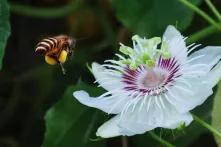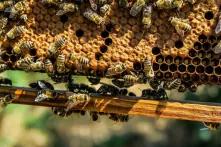
In a lawn in front of my home, there is a large yellow elder shrub, which I did not pay much attention to it, even though its crown was directly at my bedroom’s window, but right there at the evergreen shrub that always decorated with yellow trumpet-shaped flowers resides our best hope to combat adverse impacts to Bangkok’s food security from climate change.

It is common for urban citizen of Bangkok, who are too busy living rushed lifestyle, to ignore the nature around themselves. Many of them, which once including me of course, also assumed that our metropolis is just too urbanized and too polluted to sustain healthy ecosystems.
Yet my old myth has been challenged after I learned the new astonishing fact from the research on urban pollinators in Bangkok by Dr Alyssa Stewart, a professor on tropical ecology and pollinators from Department of Plant Science, Faculty of Science at Mahidol University.
At the presentation of her research on the terrace talk at Heinrich-Böll Stiftung Southeast Asia Office last month (February 19, 2020), Dr Stewart revealed that even in the dull grey city of Bangkok, totally 40 species of tropical pollinators from 6 orders including Hymenopterans (bees and wasps), Lepidoptera (butterflies and moths), Diptera (flies), Coleoptera (beetles), Hemiptera (true bugs), and one sunbird species were observed to live in Bangkok Metropolis.
It was a surprise to me to learn that these insects survive and thrive in the highly urbanized environment by taking advantage of our passion to flowers, as we have planted many kinds of flowers in the parks, public places and our houses, which provide reliable sources of nectars for them.
These urban pollinators even enjoy the special benefit from human influences that their counterparts in the wild lack, as these always be flowers in Bangkok on anytime of year, which allow them to access to nectar supply all-year-round, while the pollinators in the wild need to migrate seasonally, because the wild flowers tend to blossom on specific season.
The disclosure of urban pollinators in Bangkok, discussed in this eye-opening research, changes my view on the complexity of urban ecosystem and reminds me of the importance of these small beings in Bangkok’s nature world.
Afterwards, I tried to take a sharper look to the surrounding nature and found out myself the rhythm of the integral but largely overlooked cog that keeps Bangkok’s urban ecosystem functional and healthy right at yellow elder shrub outside my bedroom’s window, where I found many honey bees worked tirelessly to harvest nectar.
I have come to realise that these hard-working honeybees was not just coming to my home and steal nectars from the plants in my property, but they were returning favour by pollinating yellow elder and make chilis and lemon trees at my backyard bare fruits, as while they flew from one flower to another to collect nectar, they were also transporting pollens with them and helping pollinate trees in my garden.
Despite Dr Stewart remarked that the pollinators in the city do not have much significant role to the city dwellers compare to their counterparts in the rural farmlands or in the forest, which are greatly relied upon by the farmers and wild plants for their pollination service. This is because most plants in the city are cultivated and maintained by the people and therefore their pollination service is not much required.
Nevertheless, it is certain that the ecological services of urban pollinators are very essential for the Bangkok’s environment. And their crucial roles in the urban ecosystem is going to be even more increase, as the global climate is continuously warming.
As a result of worsening climate change, the scientist community has warned us that we are going to suffer the consequences from more frequent and severer weather extremes, widespread environmental degradation, and mass biodiversity loss, which are going to severely affected the environment and people around the world.
Citizens of Bangkok Metropolis are too going to be victimized by climate change, as extreme weathers such as flood and drought will not only cause direct havoc to the city, but as the people in Bangkok is greatly depend on food supply from outside the city, the damages to crops at the rural farmlands will threaten the city with food insecurity.
From my perspective, these humble pollinators can be very helpful to strengthen climate resilience of the city. Since we are facing the risk of food shortage, growing food in the city will be the fundamental measure for this problem.
As of now, there are a few organizations that started to grow urban orchards up on the skyscrapers’ terrace or on small plots within the concrete jungle. Paddy fields and vegetable garden of Siam Green Sky on the seventh floor of Siam Square One department store at the heart of Bangkok’s central business district, which initiated by Chulalongkorn University, is one of the most vivid examples.
The urban pollinators can provide major benefit for urban farming, as according to Dr. Orawan Duangphakdee, another leading researcher on Thailand’s native honeybees from Native honeybee research laboratory at King Mongkut’s University of Technology Thonburi, Ratchaburi Campus, bee pollination can substantially increase the crop’s yield.
Video below: Mr. Preecha Rod-Im is demonstrating propagation of stingless bees (Trigona laeviceps ) colony during the workshop.
Orawan also revealed that by raising honeybees to pollinate the crops can reduce the chemical usage in the farm. Moreover, we can get honey as an outgrowth of beekeeping.
As the aforementioned research by Dr Stewart found out that the most abundant pollinators in Bangkok are bees and the top five most common urban pollinators are stingless bees (64.32%), followed by three species of honey bees, Apis florea (12.99%), Apis cerana (12.48%), Apis dorsata (6.11%), and one species of carpenter bee, Xylocopa aestuans (1.45%). It is certain that these native bee species are well adapted with urban environment.
Therefore, urban apiculture is not only possible, but it is our promising mitigation measure against the threats of climate change.
This external content requires your consent. Please note our privacy policy.
Open external content on original siteHowever, honeybees and other pollinators all around the world are currently facing grave threat to their survival, as the impacts of heavy use of pesticides and climate change are wiping out large number of honey bees, especially in Europe.
The article on “Native Honey Bees of Southeast Asia and Conservation Challenges” by Eric Guerin noted that although there was no indication of the short term extinction risk of the 8 native honeybee species in Southeast Asia, but it was noticed that the population of many Southeast Asia native honeybee species was on decline in many parts of the region.
Even the more resilient pollinators in the city, Dr Stewart’s study highlighted that the diversity of pollinators in Bangkok (40 species found) was relatively lower than many major cities, as the previous studies of urban bee species richness have ranged between 37 and 64 species.
So, what we should do to conserve our small nectar-feeding neighbors by planting more flowered trees, while the policy-makers should also invest more on enlarging urban green spaces, which will not only benefit the pollinators, but also improve the quality of life for Bangkok citizens.
Since we are the main beneficiaries from the precious ecological services of these pollinators, it is our duty to ensure the survival of these tiny but hugely important animals, as Albert Einstein once warned us that our own survival depends on them and if the bees extinct, it means our extinction will soon follow.



